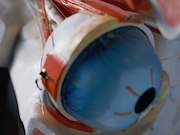Candida growth in donor rim cultures more common in endothelial keratoplasty-processed eyes
FRIDAY, Sept. 29, 2017 (HealthDay News) — Donor rim cultures are more likely to have detectable Candida growth in endothelial keratoplasty-processed eyes than for other uses, according to a study published online Sept. 28 in JAMA Ophthalmology.
Kimberly M. Brothers, Ph.D., from the University of Pittsburgh, and colleagues used data from the 2013 Eversight Eyebank Study follow-up database for 6,592 corneal transplants to determine whether eyebank-processed endothelial keratoplasty tissue is at higher risk of contamination than unprocessed tissue. To assess whether processing steps at room temperature were a potential risk factor for fungal growth, Candida albicans, Candida glabrata, and Candida parapsilosis endophthalmitis isolates were each inoculated into optisol-gentamicin and -streptomycin (GS) and subjected to two room temperature incubation regimens reflective of current corneal tissue-handling protocols.
The researchers found that donor rim culture results were three times more likely to be positive for fungi in endothelial keratoplasty-processed eyes (1.14 percent) compared with other uses (0.37 percent). Increased room temperature incubation of optisol-GS increased growth of Candida species over time. Adding caspofungin and voriconazole decreased growth of Candida in a species-dependent manner.
“Detectable Candida growth in donor rim cultures, associated with a higher rate of post-keratoplasty infection, is seen in endothelial keratoplasty tissue vs. other uses at the time of transplantation, likely owing in part to eyebank preparation processes extending the time of tissue warming. Reduced room temperature incubation and the addition of antifungal agents decreased growth of Candida species in optisol-GS and should be further explored to reduce the risk of infection,” conclude the authors.
Copyright © 2017 HealthDay. All rights reserved.








